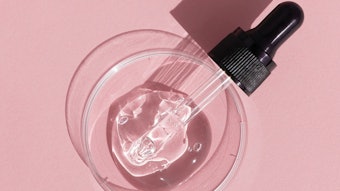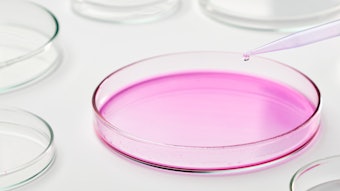
Cellulite is considered an endocrine metabolic microcirculatory disorder that causes interstitial matrix alterations and structural changes in subcutaneous adipose tissue.1 It is localized mainly on the thighs, buttocks and occasionally the abdomen, and it is characterized by an orange peel or cottage cheese appearance. Approximately 85% of women worldwide are concerned by cellulite.1
Although the cellulite pathogenesis is not fully understood, a variety of circulatory and structural changes have been identified that contribute to the orange peel appearance of the skin. First, the capillary networks of the dermis are impaired from the breakdown in blood vessel integrity, which causes fluid retention and clumping of engorged fat cells in the subcutaneous tissue. The aggregation of adipose cells and the growth of collagen fibrils further hamper microcirculation, leading to dermal metabolism reduction. Moreover, dermal thinning occurs in response to minimized protein synthesis and reduced degradation. Adipose cells isolated from nutrition and toxins removal swell to micronodules that finally agglomerate to macronodules.1–4
Cellulite is a concern for many women. Therefore, appropriate research to investigate treatment options and objective methods measuring its efficacy are warranted. The present study aims to evaluate the efficacy of an anti-cellulite product using noninvasive investigation techniques. The key skin condition parameters measured include moisturization, roughness and the thickness of subcutaneous tissue.
Materials and Methods
The described study involved 25 healthy female volunteers, ages 25–55, having grades 2 to 3 cellulite on their thighs, according to Nurnberger classification.5 An anti-cellulite cream-gel formulated with several actives reported to prevent cellulite was applied once daily for four weeks (see Anti-cellulite Test Formula).
Specifically, the formulation included a defined protein fraction of pumpkin (INCI: Hydrolyzed Cucurbita Pepo (Pumpkin) Seedcake), which has been reported to stimulate the synthesis of collagen and fibrillin and to inhibit the expression of proteolitic enzymes such as MMP-1, MMP-2 and cathepsin L. Consequently, it would be expected to protect and repair the elastic and collagen tissue. The formulation also contained L-ergothioneinea. Similar to carnitine, in slimming products, L-ergothioneine aids in the transfer of fatty acids in the mitochondria. Fatty acids are burned with oxygen, and the result is the production of energy or adenosine triphosphate (ATP).
Cranberry fruit extract (INCI: Vaccinium Macrocarpon (Cranberry) Fruit Extract) also was included for its polyphenol content to improve skin microcirculation and provide antioxidant properties. Finally, orange extract (INCI: Citrus Aurantium Dulcis (Orange) Extract) was used to exfoliate epidermal cells, enable cell renewal and stimulate skin microcirculation. The exfoliation provided by orange extract reportedly results in less visible cellulite. During the four-week study, skin moisturization and roughness and ultrasonography analyses were conducted before skin cream application and after two and four weeks of product application. All measurements were taken in a standardized manner. In addition, the test subjects completed evaluations.
Skin moisturization and roughness analysis: Skin moisturization was evaluated using corneometry and an adapter systemb with a probec. Skin roughness images were taken by a camerad and analyzed using software designed to evaluate skin microreliefse. To assess roughness, this study utilized a volume parameter defined as the volume, depth and number of skin folds.
Application of the anti-cellulite cream for two and four weeks led to an increase in corneometer values, i.e. hydration levels, compared with the baseline, as shown in Figure 1. This increase demonstrated that the anti-cellulite cream improved skin hydration. After two weeks of treatment, skin moisturization increased by 17% and after another two weeks, skin moisturization increased to 23%. Statistical analysis showed the differences in the results to be statistically significant (p < 0.001).
Consistent application of the product also resulted in a decrease in the number, depth and volume of skin folds (volume parameter) compared with the baseline, as shown in Figure 2. This decrease in the skin fold parameters demonstrated the ability of the anti-cellulite product to smooth the skin.
Skin ultrasonography: Cellulite ultrasonography also was performed using an 18-MHz ultrasound probef. Ultrasonografic images of the human skin were taken using an experimental device equipped with a 35 MHz frequency headg.6 In the images collected, the thickness of the subcutaneous tissue was assessed using software.
As shown by Figure 3, the thickness of the subcutaneous tissue decreased after four weeks of anti-cellulite cream-gel application. Before the anti-cellulite treatment, the thickness of the hypodermis was 3.4–23 mm (12.6 mm mean). After four weeks of application, the thickness was reduced to 2.2–16.6 mm (10.07 mm mean). Statistical analysis showed that the difference in these results was significant (p < 0.001). Moreover, in the data collected, the herniation of the hypodermis into the dermis was observed, as shown in Figure 4.
Statistical analysis: Overall statistical analysis was performed using a student’s t-test for dependent groups. The normality of the distribution of variables was checked with the Kolmogorow-Smirnow test. Statistical significance was defined as p < 0.05. The results of the t-test confirmed that the observed differences were statistically significant (p = 0.07, p = 0.03).
Volunteer evaluation: Each volunteer in the study completed a survey to evaluate the tested anti-cellulite product. The survey asked questions about the cosmetic features of the product such as color, consistency and fragrance, as well as the anti-cellulite effects of the product on their skin condition.
In general, the anti-cellulite cream-gel was well-received by the volunteers and no skin irritation was observed. Volunteers noted a significant improvement in the appearance of their skin during the course of a four-week cosmetic treatment. They described their skin after the product’s application as being more elastic, smooth, moisturized and as having less cellulite. This self-perception data is shown in Figures 5 and 6.
Discussion
The variety of instruments and methods currently used to test the efficacy of anti-cellulite products is broad. Up until now, studies investigating anti-cellulite treatments relied on digital photography, visual scoring, circumferential thigh measurements and subjective assessments.7–9 Additional assessments included skin roughness, elasticity and blood circulation.10–11 However, recent studies using ultrasound imaging and confocal microscopy give more insight into the structural aspects of cellulite.12–15 Moreover, standardized macrophotography, magnetic resonance imaging and automated image analysis of ultrasounds can be regarded as important tools for determining and quantifying the aspects of cellulite.1, 12–15
The use of such a variety of methods illustrates that the personal care industry is still searching for the best methods to measure anti-cellulite efficacy. This study aimed to evaluate the efficacy of an anti-cellulite product using non-invasive investigation techniques, and of the methods used, ultrasonography could potentially become more widely used as it is available and cost-effective. Ultrasound monitors the thickness and the quality of skin tissue, and using ultrasonographs with 7.5–10 MHz broadband heads allows for the imaging of subcutaneous tissue, whereas the dermis is a superficial tissue and remains beyond the reach of low frequency ultrasonography.
This study utilized ultrasonography with an 18 MHz frequency probe to demonstrate a decrease in hypodermis thickness, which is in line with ultrasound imaging data presented by Perin et al. and Ortonne et al; these authors observed a significant decline in the thickness of the thigh subcutaneous adipose tissue.3, 16 The data corroborates the well-documented structural hypodermic hypertrophy presented in cases involving cellulite.17–18
The breakthrough in the ultrasonographic imaging of superficial tissues occurred with the construction of 20–40 MHz high frequency heads. As noted, the present study utilized an experimental device equipped with a 35 MHz head.6 High frequency ultrasonography allows for the imaging of superficial tissues beyond the reach of previous ultrasonographs. Therefore, the thickness of the epidermis and dermis, the echogenicity of the dermis, the in-growth of subcutaneous tissue bands into the dermis, and the presence or absence of edemas were observed. The most useful parameters for evaluating cellulite in high frequency ultrasonography imaging were found to be the thickness of dermis, the in-growth of subcutaneous tissue band into the dermis and echogenicity since these parameters are easy to define and monitor by software. Moreover, the changes observed in these parameters are the most significant.
While using classic ultrasound examinations will also reveal the in-growth of subcutaneous tissue band into the dermis, high frequency ultrasonography allows for more detailed imaging of this band. Preliminary results showed that this area could be calculated by additional experimental ultrasonography software.6 The data discussed here matches the data described in previous literature;3, 14, 17–18 in fact, many authors have reported a deep deformation of the dermis-hypodermis interface linked with the herniation of the hypertrophic adipocytes into the dermis and increased length of the dermis-hypodermis interface.3, 17–18 Adipose protrusions into the epidermis correlate positively with skin dimpling severity. Currently, the dimpling of cellulite-affected skin is understood to result from the inability of collagen at the papillary dermis to prevent adipose protrusion through the dermis.14
The present study showed that skin moisturization, smoothness and hypodermis thickness were useful parameters in the evaluation of the cellulite treatment. Instrumental analyses corresponded well with self-perception data. Volunteers scored significant improvements in the skin’s appearance during the course of the four-week cosmetic treatment. Although these results may not indicate cellulite improvement at a structural level, they do describe an improvement in the skin appearance.
Conclusions
As the present exercise revealed, ultrasonography is useful in the objective assessment of an anti-cellulite product’s efficacy. Improvements in parameters such as dermis and hypodermis thickness, dermis echogenicity, and length of the dermis-hypodermis interface could indicate an effect on skin structure due to the rebuilding of collagen fibers. Interestingly, preliminary data on a placebo anti-cellulite formula showed no effect on skin structure and no changes in dermis thickness or echogenicity.19 Thus, monitoring these ultrasonographic parameters could be useful to create effective anti-cellulite formulas and to distinguish active treatments from placebos.
Ultrasound imaging and skin condition analysis can successfully define the efficacy of anti-cellulite products from a cosmetic point of view. Nevertheless, additional research is warranted to investigate not only anti-cellulite treatment options, but also objective methods to measure their efficacy.
References
Send e-mail to [email protected].
1. B Brewster, Anticellulite products: Ingredients and efficacy testing, Cosm & Toil 124 1 (2009)
2. T Callaghan and KP Wilhelm, Is cellulite an aging phenomenon? Cosm & Toil 120 12 (2005)
3. JP Ortonne, M Zartarian, M Verschoore, C Queille-Roussel and L Duteil, Cellulite and skin aging: Is there any interaction? JEADV 22, 827–834 (2008)
4. AV Rawlings, Cellulite and its treatment, Int J Cosmet Sci 3, 175–190 (2006)
5. F Nurnberger and G Muller, So-called cellulite: An invented disease, J Dermatol Surg Oncol 4, 221–229 (1978)
6. R Miosek et al, The use of high frequency ultrasonography in monitoring anti-cellulite therapy–own experience, Pol J Cosmetol 4 283–294 (2008)
7. LK Smalls, CY Lee, J Whitestone, WJ Kitzmiller, RR Wickett and MO Visscher, Quantitative model of cellulite: Three dimensional skin surface topography, biophisical characterization, and relationship to human perception, J Cosmet Sci 56 105–120 (2005)
8. JS Fink, H Mermelstein, A Thomas and R Trow, Use of pulsee light and retinyl-based cream as a potential treatment for cellulite: A pilot study, J Cosmet Dermatol 3 254–262 (2006)
9. J Rao, MH Gold and MP Goldman: A two-center, double-blinded, randomized trial testing the tolerability and efficacy of a novel therapeutic agent for cellulite reduction, J Cosmet Dermatol 2 93–102 (2005)
10. T Callaghan and KP Wilhelm, An examination of non-invasive imaging technigues in the analysis and review of cellulite, J Cosmet Sci 56 379–393 (2005)
11. T Callaghan, S Bielfeldt, G Springmann, P Buttgereit and KP Wilhelm, Challenges of non-invasive imaging in the understanding of cellulite, J Am Acad Dermatol 2 AB405 (2007)
12. N Collis, LA Elliot, C Sharpe and DT Sharpe, Cellulite treatment: A myth or reality: A prospective randomized, controlled trial of two therapies, endermologie and aminophylline cream, Plast Reconstr Surg 4 1110–1114 (1999)
13. M Emilia del Pino et al, Effect of controlled volumetric tissue heating with radiofrequency on cellulite and the subcutaneous tissue of the buttocks and thighs, J Drugs Dermatol 8 714–722 (2006)
14. S Bielfeldt, P Buttgereit, M Brandt, G Springmann and KP Wilhelm, Non-invasive evaluation techniques to quantify the efficacy of cosmetic anti-cellulite products, Skin Res Technol 14 336–346 (2008)
15. DM Hexsel, T Dal’Forno and CL Hexsel, A validated photonumeric cellulite severity scale, JEADV 23 523–528 (2009)
16. FC PerinPerrier, JC Pittet, P Beau, S Schnebert and P Perrier, Assessment of skin improvement treatment efficacy using photograding of mechanically-accenuated macrorelief of thigh skin, Int J Cosmet Sci 22 147–156 (2000)
17. B Querleux, C Cornillon, O Jolivet and J Bittoun, Anatomy and physiology of subcutaneous adipose tissue by in vivo magnetic resonance imaging and specroscopy: Relationships with sex and presence of cellulite, Skin Res Technol 8 118–124 (2002)
18. LK Smalls, CY Lee, J Whitestone, WJ Kitzniller, RR Wickett and MO Visscher, Quantitative model of cellulite: Three dimensional skin surface topography, biophysical characterization and relationship to human perception, J Cosmet Sci 56 105–120 (2005)
19. K Bazela, R Debowska, B Tyszczuk, E Kazmierczak et al, Effect of anti-cellulite treatment on skin condition–instrumental and subjective analysis, J Invest Dermatol 130 62 (2010)










